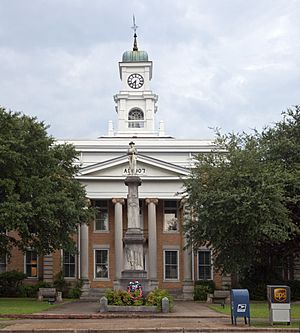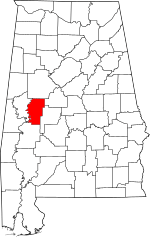Hale County, Alabama facts for kids
Quick facts for kids
Hale County
|
||
|---|---|---|

Hale County Courthouse and Confederate statue in Greensboro
|
||
|
||

Location within the U.S. state of Alabama
|
||
 Alabama's location within the U.S. |
||
| Country | ||
| State | ||
| Founded | January 30, 1867 | |
| Named for | Stephen F. Hale | |
| Seat | Greensboro | |
| Largest city | Moundville | |
| Area | ||
| • Total | 657 sq mi (1,700 km2) | |
| • Land | 644 sq mi (1,670 km2) | |
| • Water | 13 sq mi (30 km2) 1.9% | |
| Population
(2020)
|
||
| • Total | 14,785 | |
| • Estimate
(2023)
|
14,888 |
|
| • Density | 22.504/sq mi (8.689/km2) | |
| Time zone | UTC−6 (Central) | |
| • Summer (DST) | UTC−5 (CDT) | |
| Congressional district | 7th | |
|
||
Hale County is a county located in the central part of Alabama, a state in the United States. In 2020, about 14,785 people lived there. The main town, or county seat, is Greensboro. The county is named after Stephen F. Hale, who was a soldier.
Hale County is also part of the larger Tuscaloosa area.
Contents
History of Hale County

Hale County was created after the American Civil War. This happened on January 30, 1867. It was formed from parts of other counties like Greene and Tuscaloosa. Most of the land came from Greene County. The first American settlers in this area came from other southern states.
Artists and Important People
Hale County has connections to several famous artists. In 1936, Walker Evans took photos here for a book. Later, William Christenberry, an artist born nearby, also photographed buildings in Hale County.
The county is also home to the Auburn University Rural Studio. This program helps design and build homes for people in need. Eugene Sawyer, who became the second African American mayor of Chicago, was born here. In 2019, a film called Hale County This Morning, This Evening was nominated for an Academy Award. It showed how the area has changed.
Changes Over Time
After the Civil War, white people held most of the power in Hale County. For many years, African Americans were stopped from voting. This was part of a system called Jim Crow. Many African Americans moved away from the county in the early 1900s.
However, in the late 1960s, African Americans gained the right to vote again. In 1997, Greensboro elected its first black mayor, John E. Owens Jr. Later, in 2006, the county elected its first black sheriff, Kenneth W. Ellis.
Hale County has faced some economic challenges. Many factories closed in the late 1900s. This led to fewer jobs and a smaller population, especially around Greensboro. But the northern part of the county has grown. This is because it is close to Tuscaloosa, which has a growing economy and the University of Alabama.
Geography of Hale County
Hale County covers about 657 square miles. Most of this area, about 644 square miles, is land. The rest, about 13 square miles, is water.
Neighboring Counties
Hale County shares borders with these counties:
- Tuscaloosa County (to the north)
- Bibb County (to the northeast)
- Perry County (to the southeast)
- Marengo County (to the south)
- Greene County (to the west)
Protected Areas
A part of the Talladega National Forest is located in Hale County.
Population in Hale County
| Historical population | |||
|---|---|---|---|
| Census | Pop. | %± | |
| 1870 | 21,792 | — | |
| 1880 | 26,553 | 21.8% | |
| 1890 | 27,501 | 3.6% | |
| 1900 | 31,011 | 12.8% | |
| 1910 | 27,883 | −10.1% | |
| 1920 | 24,289 | −12.9% | |
| 1930 | 26,265 | 8.1% | |
| 1940 | 25,533 | −2.8% | |
| 1950 | 20,832 | −18.4% | |
| 1960 | 19,537 | −6.2% | |
| 1970 | 15,888 | −18.7% | |
| 1980 | 15,604 | −1.8% | |
| 1990 | 15,498 | −0.7% | |
| 2000 | 17,185 | 10.9% | |
| 2010 | 15,760 | −8.3% | |
| 2020 | 14,785 | −6.2% | |
| 2022 (est.) | 14,888 | −5.5% | |
| U.S. Decennial Census 1790–1960 1900–1990 1990–2000 2010–2020 |
|||
In 2020, there were 14,785 people living in Hale County. About 56% of the people were Black or African American. About 40% were White. Other groups made up a smaller part of the population.
Transportation in Hale County
Main Roads
Several important roads pass through Hale County:
Airports
There are two small airports in the county:
- Greensboro Municipal Airport in Greensboro
- Moundville Airport in Moundville
Things to See and Do (Tourism)
Greensboro, the county seat, has the Safe House Black History Museum. In 1968, Martin Luther King Jr. stayed in this house for safety. The museum tells the story of the fight for equal rights for African Americans in Alabama. Its founder, Theresa Burroughs, was a friend of King and a civil rights activist.
Greensboro also has many old houses and churches from before the Civil War. Some of these are listed on the National Register of Historic Places. Examples include Glencairn and Magnolia Grove.
Education in Hale County
All students in Hale County attend schools in the Hale County School District.
Communities in Hale County
City
- Greensboro (the county seat)
Towns
- Akron
- Moundville (partly in Tuscaloosa County)
- Newbern
Unincorporated Communities
These are smaller places that are not officially towns or cities:
Ghost Towns
These are places where people used to live, but now they are empty:
Notable People from Hale County
- William Christenberry (1936–2016), a famous artist and photographer, was born in Hale County.
See also
 In Spanish: Condado de Hale (Alabama) para niños
In Spanish: Condado de Hale (Alabama) para niños

